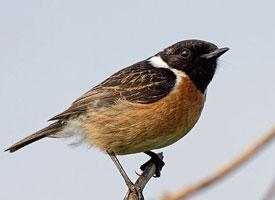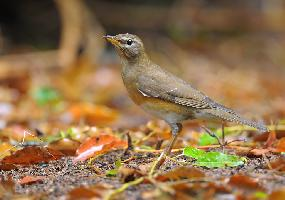
Description de l'animal
The European Stonechat (Saxicola rubicola) is a small, charismatic bird belonging to the chat family, Muscicapidae. It is predominantly found across Europe, western Asia, and the northern parts of Africa. This bird is especially noted for its distinctive call, which sounds like two stones being tapped together, hence the name "stonechat." The European Stonechat is a bird of open country, thriving in heathlands, moorlands, rough grasslands, and near coastal cliffs where it can often be seen perched on the top of a bush or small tree.In terms of appearance, the European Stonechat is a compact bird with a relatively short tail and a robust body, measuring about 12-13 cm in length. The male in breeding plumage is particularly striking with a black head, white around the side of the neck, a bright orange-red breast, and a black upper body contrasting sharply with a white rump. The female, while more subdued in color, is equally beautiful, featuring a paler orange breast and a brown back, making her well camouflaged against the heathland vegetation.
One of the most fascinating aspects of the European Stonechat is its seasonal plumage variation. In winter, the male's black feathers are edged with brown, giving him a more muted appearance, which helps with camouflage during the non-breeding season. Both sexes undergo a molt in late summer, after which they sport their fresh feathers for the winter.
The diet of the European Stonechat is varied, consisting mainly of insects such as beetles, flies, and caterpillars during the warmer months. During the winter, when insects are less abundant, they will also eat seeds and small fruits. They are often seen flicking their wings and tail as they dart from their perch to catch prey on the ground.
Breeding typically occurs from April to July. The European Stonechat is monogamous, and pairs often stay together throughout the year. The nest is a well-hidden cup built by the female in dense vegetation, into which she will lay between four to six eggs. The eggs are incubated primarily by the female for about two weeks before hatching. Both parents are involved in feeding the chicks, which fledge about two weeks after hatching.
One of the challenges facing the European Stonechat is habitat loss due to agricultural intensification, afforestation, and urbanization. However, in some areas, conservation efforts have been successful in maintaining and even increasing their habitats, particularly in protected areas.
Despite these challenges, the European Stonechat is currently listed as Least Concern by the IUCN, thanks to its wide range and relatively stable population. Their adaptability to different habitats, including human-altered landscapes like golf courses and parks, has also helped in maintaining their numbers.
In summary, the European Stonechat is a fascinating bird, both in terms of appearance and behavior. Its presence enriches the biodiversity of the habitats it occupies, and its cheerful call is a welcome sound in the countryside. Conservation efforts to preserve its habitats are crucial to ensuring that future generations can continue to enjoy the sight and sound of this delightful bird.
Animaux similaires
Nouvelles photos d'animaux
Top 10 des animaux
- Dolphin gull (Leucophaeus scoresbii)
- Diana monkey (Cercopithecus diana)
- Moustached guenon (Cercopithecus cephus)
- Galápagos tortoise (Geochelone nigra complex)
- Japanese macaque (Macaca fuscata)
- Stone loach (Barbatula barbatula)
- Russian tortoise (Testudo horsfieldii)
- Greek tortoise (Testudo graeca)
- Common flying dragon (Draco volans)
- Vendace (Coregonus albula)


